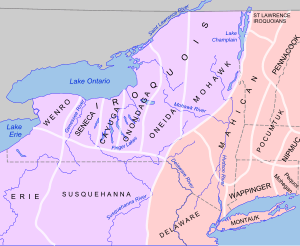History of New York (state) facts for kids
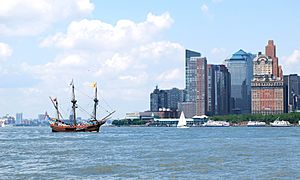
The history of New York State started about 12,000 years ago when the first people arrived. By 1100 A.D., two main groups, the Iroquoian and Algonquian people, had developed strong cultures. Europeans first explored New York in 1524 with Giovanni da Verrazzano. Then, in 1609, the Dutch claimed the land. This area, called New Netherland, was important for the fur trade and later for farming.
In 1626, the Dutch believed they bought Manhattan Island from Native Americans. But in 1664, England took control and renamed the colony New York. This was in honor of the Duke of York and Albany, who was the brother of King Charles II. New York City became a major trading port in the Thirteen Colonies during the 1700s.
New York played a big part in the American Revolution and the war that followed. The Stamp Act Congress in 1765 brought together leaders from different colonies to stand up to British rules. The Sons of Liberty group was very active in New York City, challenging British power. After a big loss at the Battle of Long Island, the American army had to leave the New York City area. This left the important port to the British for the rest of the war.
The Battle of Saratoga was a turning point in the war for the Americans. It convinced France to become their ally. New York's own constitution was created in 1777. It greatly influenced the United States Constitution. New York City was the national capital at different times between 1785 and 1790. This is where the Bill of Rights was written. Albany became the permanent state capital in 1797. In 1787, New York became the eleventh state to approve the United States Constitution.
New York saw major improvements in transportation during the 1800s. The first steamboat line started in 1807. The Erie Canal opened in 1825, and America's first regular train service began in 1831. These changes helped people settle in western New York. They also created trade connections to the Midwest around the Great Lakes.
During the American Civil War, New York City had ties to the South. Some people in the city even wanted to leave the Union. But New York State ended up sending the most soldiers and money to support the Union side. After the war, the state helped start the industrial age. This led to some of the first labor unions forming here.
In the 1800s, New York City became the main entry point for European immigrants coming to the United States. Many Irish people arrived during their Great Famine. Millions came through Castle Clinton in Battery Park. Later, Ellis Island opened in 1892, welcoming millions more, especially from eastern and southern Europe. The Statue of Liberty opened in 1886 and became a symbol of hope. New York boomed during the Roaring Twenties, a time of great prosperity. Even after the Wall Street Crash of 1929, tall skyscrapers showed the city's energy. New York City had the tallest buildings in the world from 1913 to 1974.
The building of defense industries for World War II helped New York's economy recover from the Great Depression. Hundreds of thousands of people worked to help defeat the Axis powers. After the war, many people moved to suburbs around major cities. The Thruway highway system opened in 1956, bringing new transportation advancements.
After facing near-bankruptcy in the late 1970s, New York City became a cultural center again. More immigrants arrived, and new music styles developed. The city grew from a publishing hub to a media capital in the second half of the 1900s. It became home to many national news channels and famous newspapers. The state's manufacturing jobs decreased, and New York moved towards service industries.
Contents
- Early People and Cultures
- First European Explorers
- Dutch and British Control
- New York as a British Colony (1664–1776)
- New York and the American Revolution
- From Statehood to the Civil War
- New York in the American Civil War
- After the Civil War to 1901
- Early 1900s and the Great Depression
- World War II and Modern Times
- Late 20th Century Changes
- 21st Century (2001–Present Day)
Early People and Cultures
The first people arrived in what is now New York around 10,000 BC. Around 800 AD, ancestors of the Iroquois moved into the area from the Appalachian Mountains. By 1100, the distinct Iroquoian-speaking and Algonquian-speaking cultures had fully developed.
The five nations of the Iroquois League formed a powerful group around the 1400s. They controlled land across present-day New York and into Pennsylvania. For centuries, the Mohawk people grew corn in the lowlands of the Mohawk River. Later, Dutch settlers took over these lands. The Iroquois nations to the west also had well-tended farms and fruit trees.
The Iroquois controlled the fur trade in their territory. They traded with European colonists. Other New York tribes were often taken over by Europeans or joined the Iroquoian group. The Iroquois were very involved with the Europeans because their lands were between French and English settlements.
Algonquian tribes were not as united as the Iroquois. They usually lived along rivers, streams, or the Atlantic Coast. Both groups of Native Americans had complex cultures and economies. They hunted, gathered, made goods, and farmed. The Iroquois often met at a place in Onondaga to discuss how to deal with Europeans.
Some of the tribes who lived in New York were the Iroquois, Mohawk, Mohican, Susquehannock, Petun, Chonnonton, Ontario, and Nanticoke.
First European Explorers
In 1524, Giovanni da Verrazzano, an Italian explorer working for France, explored the Atlantic coast. He sailed into New York Harbor on April 17, 1524. He described "a vast coastline with a deep delta where every kind of ship could pass." He also noted that it opened into a "beautiful lake" filled with native boats. He landed on the tip of Manhattan and possibly on Long Island.
In 1535, Jacques Cartier, a French explorer, was the first European to map the Saint Lawrence River. He sailed as far upriver as the site of Montreal.
Dutch and British Control
On April 4, 1609, Henry Hudson, working for the Dutch East India Company, sailed from Amsterdam on the ship Halve Maen (Half Moon). On September 3, he reached the mouth of the Hudson River. He sailed up the river to near Albany. His journey helped the Dutch claim the region. A trading post was set up in Albany in 1614, leading to a successful fur trade.
In 1614, the Dutch built Fort Nassau (now Albany). This was the first Dutch settlement in North America and the first European settlement in what would become New York. It was later replaced by Fort Orange in 1623.
The British took over New Netherland in 1664. The terms of surrender were fair, so there was little resistance. The colony and city were both renamed New York. "Beverwijck" was renamed Albany. This was all in honor of James II, who was the Duke of York and Albany. At the time of the British takeover, New Netherland had about 7,000–8,000 people.
New York as a British Colony (1664–1776)
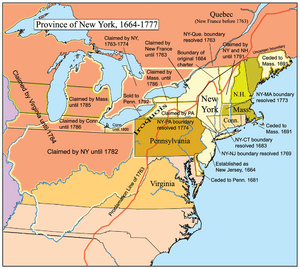
After 1700, thousands of poor German farmers, mostly from the Palatine region of Germany, moved to upstate New York. They kept their own customs, spoke German, and attended Lutheran churches. They focused on owning their own farms. Some learned English to deal with legal and business matters.
Large manors (big estates) were built along the Hudson River by wealthy colonists in the 1700s. These included Livingston, Cortlandt, Philipsburg, and Rensselaerswyck. These manors covered more than half of the colony's undeveloped land. New York grew strong during this time. Its economy was boosted by farming on Long Island and in the Hudson Valley. Trade and craft activities at the Port of New York also helped. The colony supplied food and lumber to the British sugar colonies in the Caribbean. New York's population grew a lot in this century. It went from 18,067 people in 1698 to 168,007 in 1771.
New York and the American Revolution
New York played a key role in the American Revolutionary War. The colony was close to rebellion after the Stamp Act of 1765. The Sons of Liberty in New York City became very important in politics. The Stamp Act made the colony's economic problems worse. Even though New York City merchants lost money from military contracts, they tried to find a middle ground between the King and the people. However, by April 1775, after the Battles of Lexington and Concord, compromise was no longer possible.
New York's central location and port made it vital for controlling the colonies. The British gathered a huge fleet, with 30,000 British soldiers and sailors anchored off Staten Island. General George Washington barely escaped New York City with his army in November 1776. General Sir William Howe successfully drove Washington out. The British held New York City for the rest of the war, using it as a base.
In October 1777, American General Horatio Gates won the Battle of Saratoga. This is seen as the turning point of the war. If Gates had lost, the rebellion might have failed. Losing Saratoga would have meant losing the Hudson–Champlain area, which would have separated New England from the other colonies.
From Statehood to the Civil War
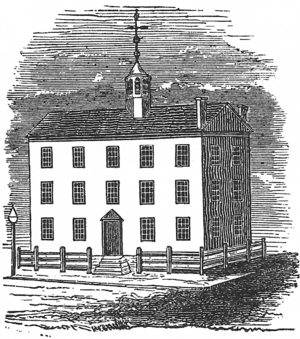
After the war, New York's borders were set. The counties east of Lake Champlain became Vermont. Many Iroquois people had supported the British. Many were killed during the war, and others went into exile. Those who remained lived on twelve reservations. By 1826, only eight reservations were left, and they still exist today.
New York adopted its constitution in April 1777. It created a strong executive branch and a clear separation of powers. This constitution greatly influenced the federal constitution ten years later. The debate over the federal constitution in 1787 led to two groups: Federalists (mostly from New York City) who wanted a strong national government, and Antifederalists (mostly from upstate) who opposed large national institutions. In 1787, Alexander Hamilton, a Federalist from New York, wrote the first essay of the Federalist Papers. He published most of the series in New York City newspapers to support the proposed United States Constitution. Even though Antifederalists were not convinced, New York ratified the Constitution in 1788.
In 1785, New York City became the national capital. It remained so on and off until 1790. George Washington was sworn in as the first President of the United States in front of Federal Hall in 1789. The United States Bill of Rights was written there, and the United States Supreme Court met for the first time. From statehood until 1797, the Legislature often moved the state capital between Albany, Kingston, Poughkeepsie, and New York City. After that, Albany became the permanent capital.
In the early 1800s, New York became a leader in transportation. In 1807, Robert Fulton started the first successful steamboat line from New York to Albany. By 1815, Albany was a major turnpike center. This made the city a hub for pioneers moving west to Buffalo and the Michigan Territory.
In 1825, the Erie Canal opened, making New York economically powerful. It connected the Atlantic Ocean and the Great Lakes. This canal joined different parts of the state and created a huge economic area for New York City. It also provided a market for farm products from the state's interior. Western New York changed from a "frontier" to a settled area. By this time, most counties and towns were established. In 1831, the Mohawk and Hudson Railroad started the country's first successful regular steam train service.
Better transportation quickly led to settlement in the fertile Mohawk and Gennessee valleys and the Niagara Frontier. Buffalo and Rochester grew very quickly. Many people from New England (mostly of English descent) moved to central and western New York. This led to small disagreements with the more settled "Yorkers" (mostly of German, Dutch, and Scottish descent). By 1840, New York had seven of the nation's thirty largest cities.
During this time, towns built academies for education, including for girls. Western New York was a center for progressive ideas. These included supporting abolitionism (ending slavery), temperance (limiting alcohol), and women's rights. New religious movements also started, like the Latter Day Saint movement founded by Joseph Smith. Some people who supported ending slavery helped runaway slaves reach freedom in Canada or New York through the Underground Railroad.
In the early 1840s, the state legislature and Governor William H. Seward expanded rights for free Black people and runaway slaves. In 1840, laws were passed to protect African Americans from Southern slave-catchers. One law gave alleged runaway slaves the right to a jury trial in New York. Another promised state help to recover free Black people who had been kidnapped into slavery. In 1841, Seward signed a law that immediately freed slaves brought into the state. Seward also signed a law to create public education for all children.
New York's culture also grew in the first half of the 1800s. In 1809, Washington Irving wrote the funny A History of New York. In 1819, he set Rip Van Winkle and The Legend of Sleepy Hollow in Hudson Valley towns. Thomas Cole started the Hudson River School in the 1830s, painting beautiful landscapes of the Hudson Valley. The first baseball teams formed in New York City in the 1840s. Professional baseball later put its Hall of Fame in Cooperstown. Saratoga Race Course, a popular summer horse racing track, opened in 1847.
New York in the American Civil War
A war was not good for business in New York. The state had strong ties to the South through the port of New York and textile mills that used Southern cotton. Before the war, half of New York City's exports were related to cotton. Southern businessmen often visited the city. The city's large Democrat community worried about Abraham Lincoln's election in 1860. The mayor even suggested New York City should leave the Union.
By the time of the 1861 Battle of Fort Sumter, these political differences lessened. New York quickly sent soldiers and supplies when Lincoln asked. Hundreds of thousands of young men from New York fought in the Civil War. This was more than any other Northern state. No battles were fought in New York, but there were Confederate plans to burn cities and invade the state from Canada.
In January 1863, Lincoln issued the Emancipation Proclamation, which freed slaves in states that were still rebelling. In March 1863, the federal draft law changed. Men between 20 and 35, and unmarried men up to 45, had to join the army. Those who could afford to hire a substitute or pay $300 were excused. Anti-war newspapers criticized the law. Many immigrants felt it was unfair that they had to fight while richer people could pay their way out. On July 13, 1863, five days of large-scale riots began. These riots were mostly by Irish immigrants. They attacked Black people, their neighborhoods, and people who supported ending slavery. As a result, many Black people left Manhattan permanently and moved to Brooklyn or other areas.
After the Civil War to 1901
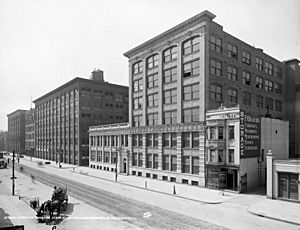
In the decades after the Civil War, New York became even stronger in finance and banking. Manufacturing continued to grow. Famous companies founded during this time include Eastman Kodak (1888 in Rochester), General Electric (in Schenectady), and Endicott-Johnson Shoe Company (in the Triple Cities). Buffalo and Niagara Falls attracted many factories because of hydroelectric power in the area.
As industry grew, workers in New York began to form unions as early as the 1820s. By 1882, the Knights of Labor in New York City had 60,000 members. Trade unions used their political power to limit working hours as early as 1867. At the same time, New York's farm output reached its highest point. Farming changed from growing crops to dairy farming. The cheese industry became big in the Mohawk Valley. By 1881, the state had over 241,000 farms. The area around New York Harbor became the world's oyster capital, a title it held into the early 1900s.
Immigration increased throughout the late 1800s. Starting with people fleeing the Great Famine of Ireland in the 1840s, New York became a main entry point for those seeking a new life in the United States. Between 1855 and 1890, about 8 million immigrants passed through Castle Clinton at Battery Park in Manhattan. Early on, most immigrants came from Ireland and Germany. Ellis Island opened in 1892. Between 1880 and 1920, most immigrants were German, Eastern European Jews, Poles, and other Eastern and Southern Europeans, including many Italians. By 1925, New York City's population was larger than London's, making it the most populated city in the world.
New York's most famous symbol, the Liberty Enlightening the World (the Statue of Liberty), was a gift from France for the American centennial. It was finished in 1886. By the early 1900s, the statue was known as the "Mother of Exiles"—a symbol of hope for immigrants.
New York's political patterns did not change much after the mid-1800s. New York City and its surrounding area were strongly Democratic. Upstate New York supported the Republican Party and was a center for people who wanted to end slavery. In the 1850s, the Democratic Tammany Hall became one of the most powerful political organizations in U.S. history. Boss William Tweed brought the group to power in city and state politics in the 1860s. Tammany Hall kept its influence until at least the 1930s. Outside the city, Republicans were able to control the redistricting process enough to limit New York City's power and take control of the Legislature in 1894.
Early 1900s and the Great Depression

By 1901, New York was the richest and most populated state. Two years earlier, the five boroughs of New York City became one city. Within decades, the city's symbol became the skyscraper. The Woolworth Building was the tallest building in the world from 1913. It was surpassed by 40 Wall Street in April 1930, the Chrysler Building in 1930, the Empire State Building in 1931, and the World Trade Center in 1972.
At the start of the 1900s, the state had over a dozen major railroads. Electric Interurban rail networks also began to appear around Syracuse, Rochester, and other New York cities.
In the late 1890s, Governor Theodore Roosevelt and other Republicans worked with Democrats like Al Smith to promote Progressivism. They fought against large companies that controlled industries (especially insurance). They also pushed for efficiency, fought waste, and called for more democracy in politics.
Democratic political groups, especially Tammany Hall in Manhattan, were against women getting the right to vote. They worried that more female voters would weaken their control over male voters. However, by the time of the New York State vote on women's suffrage in 1917, some wives and daughters of Tammany Hall leaders were working for suffrage. This led Tammany Hall to stay neutral, which was important for the vote to pass.
After a short economic downturn, New York had a booming economy during the Roaring Twenties. New York suffered during the Great Depression, which began with the Wall Street crash in 1929. The Securities and Exchange Commission opened in 1934 to regulate the stock market. Franklin Delano Roosevelt was elected governor in 1928. The state faced over 25% unemployment. His Temporary Emergency Relief Agency, started in 1931, was the first work relief program in the nation. It influenced the national Federal Emergency Relief Administration. Roosevelt was elected President in 1932 partly because he promised to bring New York-style relief programs across the country through his New Deal. In 1932, Lake Placid hosted the III Olympic Winter Games.
World War II and Modern Times
As the largest state, New York again provided the most resources during World War II. New York made 11 percent of all U.S. military weapons during the war. The state had 31,215 casualties. The war changed the state both socially and economically. For example, to fight against unfair labor practices, Governor Herbert H. Lehman created the Committee on Discrimination in Employment in 1941. Governor Thomas E. Dewey signed the Ives–Quinn bill in 1945, which banned job discrimination. The G.I. Bill of 1944 offered returning soldiers affordable higher education. This forced New York to create a public university system because its private universities could not handle all the new students. The State University of New York was created by Governor Dewey in 1948.
World War II was New York's last great industrial period. After the war, the defense industry shrank. The economy shifted towards providing services instead of making goods. Returning soldiers often took jobs from women and minority workers who had entered the workforce during the war. Companies moved to the south and west for lower taxes and cheaper, non-union workers. Many workers followed these jobs.
The middle class grew and created suburbs, like those on Long Island. The automobile sped up this move away from city centers. Planned communities like Levittown offered affordable homes for the middle class.
Larger cities stopped growing around 1950. Growth only started again in New York City in the 1980s. Buffalo's population fell by half between 1950 and 2000. Less immigration and workers moving away caused New York State's population to drop for the first time between 1970 and 1980. California and Texas both became more populated than New York.
New York began its third era of huge transportation projects by building highways, especially the New York State Thruway. This project was not popular with New York City Democrats, who called it "Dewey's ditch." They felt it mostly helped upstate New York. The highway was based on the German Autobahn and was unlike anything seen in the U.S. at that time. It was within 30 miles (48 km) of 90% of the population when it was planned. The full 427-mile (687 km) project cost $600 million and opened in 1956.
Nelson Rockefeller was governor from 1959 to 1973 and changed New York politics. He started as a liberal but became more conservative. He limited the growth of SUNY and responded strongly to the Attica Prison riot. The World Trade Center and other large projects almost caused New York City to go bankrupt in 1975. The state took control of much of the city's budget, which eventually led to better financial management.
The Governor's office was taken back by Democrats in 1974. It stayed under Democratic control for 20 years with Hugh Carey and Mario Cuomo. By the late 1900s, Democrats became more moderate. This included U.S. Senator Daniel Patrick Moynihan (1977–2001) and New York City Mayor Ed Koch (1978–1989). State Republicans started to align with the more conservative national party. They gained power with the elections of Senator Alfonse D'Amato in 1980, Mayor Rudolph Giuliani in 1993, and Governor George Pataki in 1994. New York remained one of the most liberal states. In 1984, Ronald Reagan was the last Republican to win the state in a presidential election. However, Republican Michael Bloomberg served as New York City mayor in the early 2000s.
Late 20th Century Changes
In the late 1900s, telecommunication and high technology industries employed many New Yorkers. New York City was especially good at this change. Many small companies were started by entrepreneurs, while older industrial firms like Polaroid struggled. This success attracted many young professionals to the still-shrinking cities. New York City was an exception and continued to attract new residents. The city's energy created new attractions and businesses. Some believe that changes in policing made the city safer. Crime rates dropped, and urban development reduced urban decay.
This led to a surge in culture. New York City became, once again, a center for "all things chic and trendy." Hip-hop and rap music, led by New York City, became the most popular music style. Immigration to both the city and state increased.
New York City increased its already large share of television programming. It became home to the main network news broadcasts and two of the three major cable news networks. The Wall Street Journal and The New York Times became two of the three "national" newspapers, read across the country. New York also increased its dominance in the financial services industry, centered on Wall Street. This was helped by banking growth, a rising stock market, and new ideas in investment banking.
Upstate New York did not do as well as downstate. The major industries that helped New York City did not usually spread to other regions. The number of farms in the state fell to 30,000 by 1997. City populations continued to decline, while suburbs grew in area but not as much in population. High-tech industry grew in cities like Corning and Rochester. Overall, New York entered the new millennium feeling economically strong and hopeful.
21st Century (2001–Present Day)
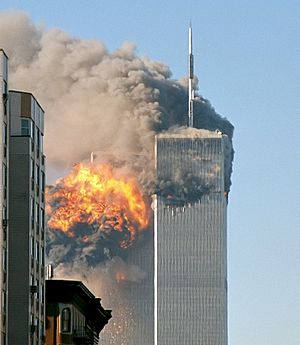
In 2001, New York entered a new era after the 9/11 attacks. This was the worst terrorist attack ever on American soil. Two of the four hijacked passenger jets crashed into the Twin Towers of the World Trade Center, destroying them. Almost 3,000 people died. Another plane flew into the Pentagon. The last plane crashed in a field after passengers fought back. Thousands of New Yorkers volunteered to search the ruins for survivors and remains in the weeks that followed.
After the attacks, plans were made to rebuild the World Trade Center site. 7 World Trade Center was the first skyscraper to be rebuilt, opening five years after the attacks. One World Trade Center, four more office towers, and a memorial to the victims of the September 11 attacks were built. One World Trade Center opened on November 3, 2014.
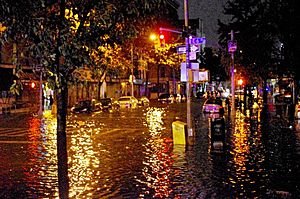
On October 29 and 30, 2012, Hurricane Sandy caused a lot of damage to the state's coastlines. It hit parts of New York City, Long Island, and southern Westchester with record-high storm surge. Severe flooding and strong winds caused power outages for hundreds of thousands of New Yorkers. It also led to gasoline shortages and problems with mass transit systems. The storm and its effects have led to discussions about building seawalls and other coastal barriers around New York City and Long Island. This is to reduce the risk from future storms, which are considered likely due to global warming and rising sea levels.


